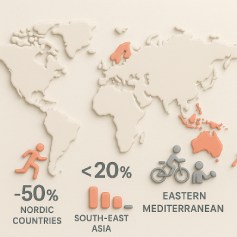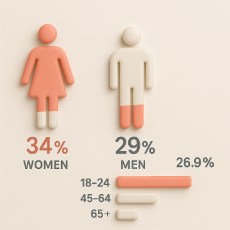World Overview of Activity Levels
According to the World Health Organization (WHO), the recommended level of physical activity is not achieved by 31% of adults globally. That means nearly 1.8 billion people are insufficiently active, thereby putting themselves at risk for heart disease, diabetes, and obesity. It is recommended that adults perform at least 150 minutes of moderate-intensity aerobic activity a week in addition to muscle-strengthening exercises at least two days.
Sources:
- World Health Organization. Physical activity.
Regional Activity Patterns

Rates of physical activity vary widely across the globe. Countries with the richest economies in Western Europe and the Nordic Region also appear to have the greatest proportion of adults meeting activity guidelines, with South-East Asia and the Eastern Mediterranean showing lower levels. For example:
- More than 50% of adults in Nordic countries meet both aerobic and muscle-strengthening recommendations.
- Below 20% in South-East Asia meet WHO activity targets.
Urbanisation, cultural beliefs, and the availability of parks contribute to such variations.
Sources:
- Eurostat, Health-enhancing physical activities statistics, 2019.
Gender and Age Differences

Worldwide, the prevalence of physical inactivity is higher in women than in men: the rates being 34% and 29%, respectively. This discrepancy can set into motion social norms and behaviors alternating with concerns about security and restrictions on access to exercise facilities.
Then it also has to do with age. The activity levels decrease with growing age, for instance, in the EU, about 26.9% of those aged 18-24 meet the recommended activity levels which drop considerably to 7.4% for those above 65 years of age. Promoting physical activity among the elderly is essential for their independence and maintenance of quality of life.
Sources:
- WHO Global Health Observatory, Physical activity statistics.
- Eurostat, EHIS 2019.
Adolescents and Youth Activity
According to the WHO report, 81% of adolescents aged 11-17 do not get at least one hour of moderate-to-vigorous physical activity per day. Here lies the difference: 85% of girls do not reach the activity goals, whereas only 78% of boys fail to. It is up to schools and community programs to raise youth activity levels.
Sources:
- World Health Organization. Global recommendations on physical activity for health.
Socioeconomic Factors
Income and education constitute important factors influencing physical activity. People with a higher education level or higher income are more likely to carry out at least 150 minutes of aerobic activity in a week:
- High education: 42.4%
- Medium education: 32.8%
- Low education: 20.5%
Similarly, adults in the highest income quintile are more active (39.5%) than those in the lowest income quintile (26.3%): differences in the availability of resources, an environment in which they can safely practice physical activity, and leisure time.
Sources:
- Eurostat, Health-enhancing physical activity statistics, 2019.
- WHO Global Health Observatory.
Types of Activity
Walking is the most common non-work-related physical activity worldwide. In Europe, virtually all adults walk at least once a week to reach any destination, whereas cycling remains a less common activity, 61% in the Netherlands and below 10% both in Portugal and Malta. There through are great variations among countries as to other sports for leisure and muscle-strengthening activities, and the Nordic countries rank high in all of them.
Sources:
- Eurostat, EHIS 2019.
- WHO, Physical activity fact sheet.
Tackling Inactivity Across the Globe
The shifting trend in global physical activity has brought inactivity to the forefront of public health concerns, affecting billions of people today. Regional, gender, age- and socioeconomic-based differences highlight specific areas that require targeted intervention. Several measures toward promoting exercise opportunities that are accessible, safe, and enjoyable, as recommended by the Self-Care Data Foundation, will provide the much-needed improvement to global health outcomes.
